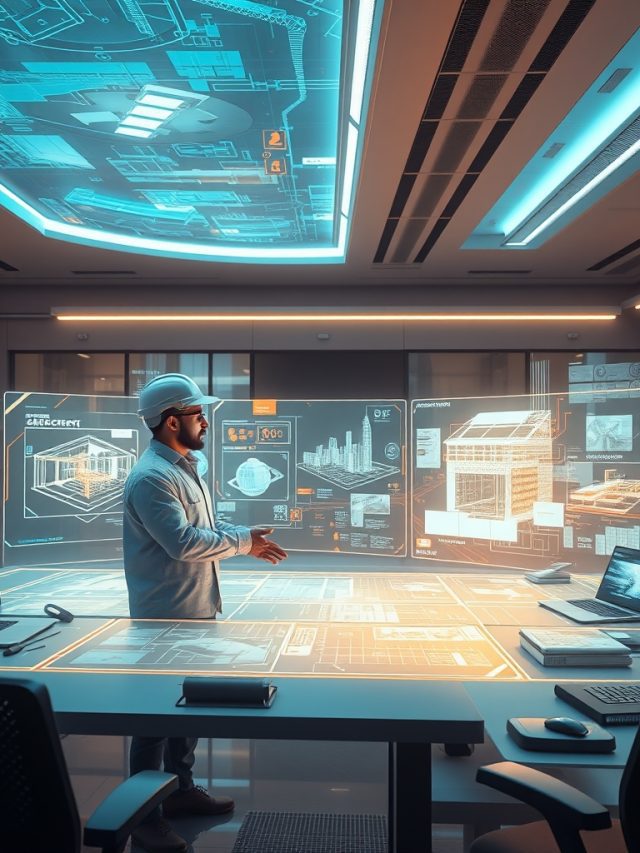Artificial intelligence (AI) is redefining the architectural landscape, evolving from a futuristic concept into a practical tool that drives efficiency, sustainability, and unprecedented creativity. We are witnessing a technological revolution in the AEC (Architecture, Engineering, and Construction) industry, moving far beyond simple CAD to embrace intelligent design partners. The integration of AI in architecture is not about replacing human creativity but augmenting it, allowing us to solve complex design challenges faster and more effectively than ever before.
Table of Contents
This shift is critical for meeting modern demands, from achieving ambitious sustainability goals to managing complex urban projects and personalizing spaces at scale. This guide explores how AI is used in architecture today, supported by real-world examples from leading firms, a comparison of essential tools, and a look at the future of the profession. The market for AI in construction alone is projected to surpass $14 billion by 2030, signaling a permanent change in how we design and build.

What Exactly Is AI Architecture?
To understand the impact of AI in architecture, it’s essential to grasp the core technologies driving this change. It’s more than just a buzzword; it represents a new design paradigm built on data, learning, and computational power. This shift from manual instruction to automated intelligence is what makes modern artificial intelligence architecture so transformative.
Defining the Pillars: AI, Machine Learning, and Generative Design
These terms are often used interchangeably, but they represent distinct layers of intelligence that empower architects.
- Artificial Intelligence (AI): This is the broad concept of creating machines that can think, learn, and solve problems like humans. In architecture, AI is the senior partner that oversees complex processes, from interpreting a design brief to managing construction logistics.
- Machine Learning (ML): This is a subset of AI where algorithms are “trained” on vast datasets to recognize patterns and make predictions. Think of ML as the associate who learns from every past project—identifying what makes a design successful, energy-efficient, or cost-effective.
- Generative Design: This is a specific application where designers input goals and constraints, and the AI explores thousands of potential solutions. It’s like a tireless intern who sketches every possible layout to find the optimal one, presenting the best options back to the architect.
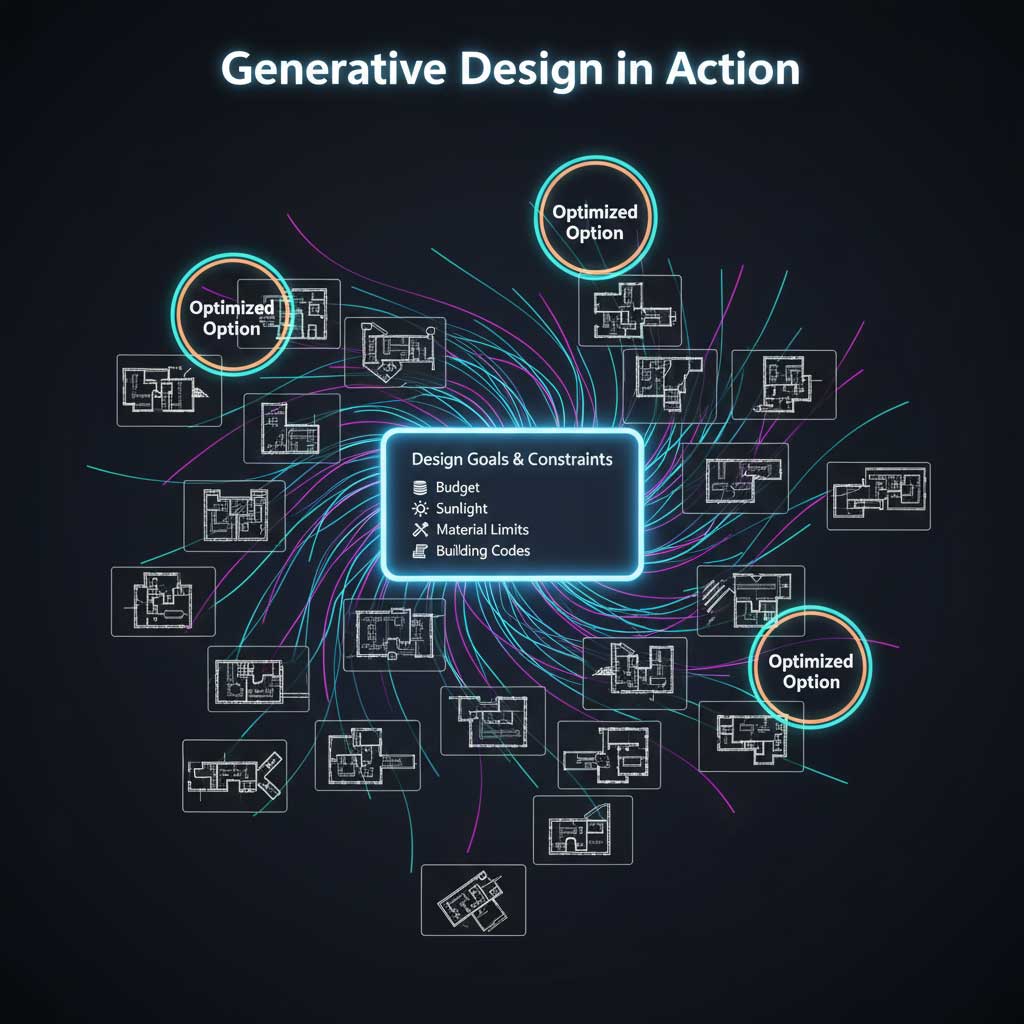
The Evolution from CAD to AI: A New Design Paradigm
The architect’s toolkit has evolved dramatically over the last century. We moved from manual drafting to 2D Computer-Aided Design (CAD), which digitized drawings. Then came 3D Building Information Modeling (BIM), which created intelligent, data-rich models.
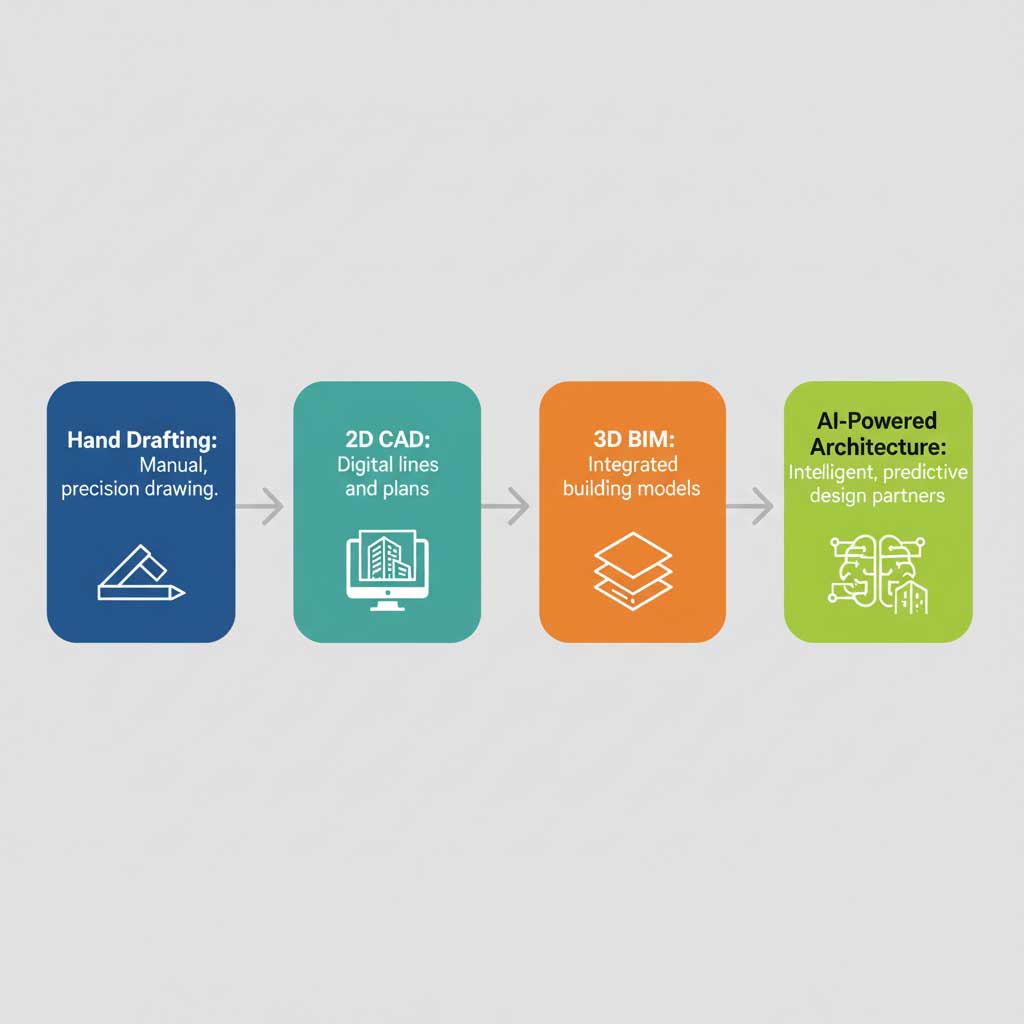
Now, we are entering the era of AI-powered architecture. This new paradigm doesn’t just represent the building; it actively participates in its design. AI can analyze, optimize, and even create, shifting the architect’s role from a drafter to a strategic director of complex design systems. This evolution allows AI for architects to become an indispensable collaborative tool.
5 Transformative Applications of AI in Architecture (with Real Examples)
Artificial intelligence architecture isn’t just theoretical; it’s being actively used by leading firms to push the boundaries of design. Here are five of the most impactful applications changing the field today.
1. Generative Design: Automating Creativity and Optimization
Generative design architecture is arguably the most exciting application of AI for creatives. It allows architects to co-create with an algorithm, inputting specific goals and constraints to generate a vast array of optimized design options that a human could never produce alone.
How It Works
An architect defines the project’s parameters: spatial requirements, structural limits, material costs, building codes, and even abstract goals like “maximize natural light” or “encourage collaboration.” The generative design software then uses machine learning to produce thousands of valid design permutations, learning and iterating with each one.
Benefits of Generative Design
- Massive Time Savings: It reduces the conceptual design phase from weeks to hours.
- Exploration of Novel Solutions: AI can produce unexpected and highly efficient designs that defy conventional thinking.
- Data-Driven Optimization: Every option is measured against the initial goals, ensuring the final selections are truly the best possible solutions.
Case Study: Autodesk Technology Centre in Toronto
A prime example of generative design architecture in action is the Autodesk office in Toronto. Designers used this technology to create an office layout that balanced dozens of competing needs, including team adjacencies, access to daylight, work style preferences, and views of the outside. The AI generated thousands of options, allowing the design team to choose a final layout that was mathematically optimized for employee satisfaction and productivity.
2. Supercharging BIM with AI: From Smart Models to Predictive Insights
Building Information Modeling (BIM) created a data-rich foundation for modern construction. Now, AI and BIM are converging to make these models truly intelligent, capable of predicting issues and automating complex coordination tasks.
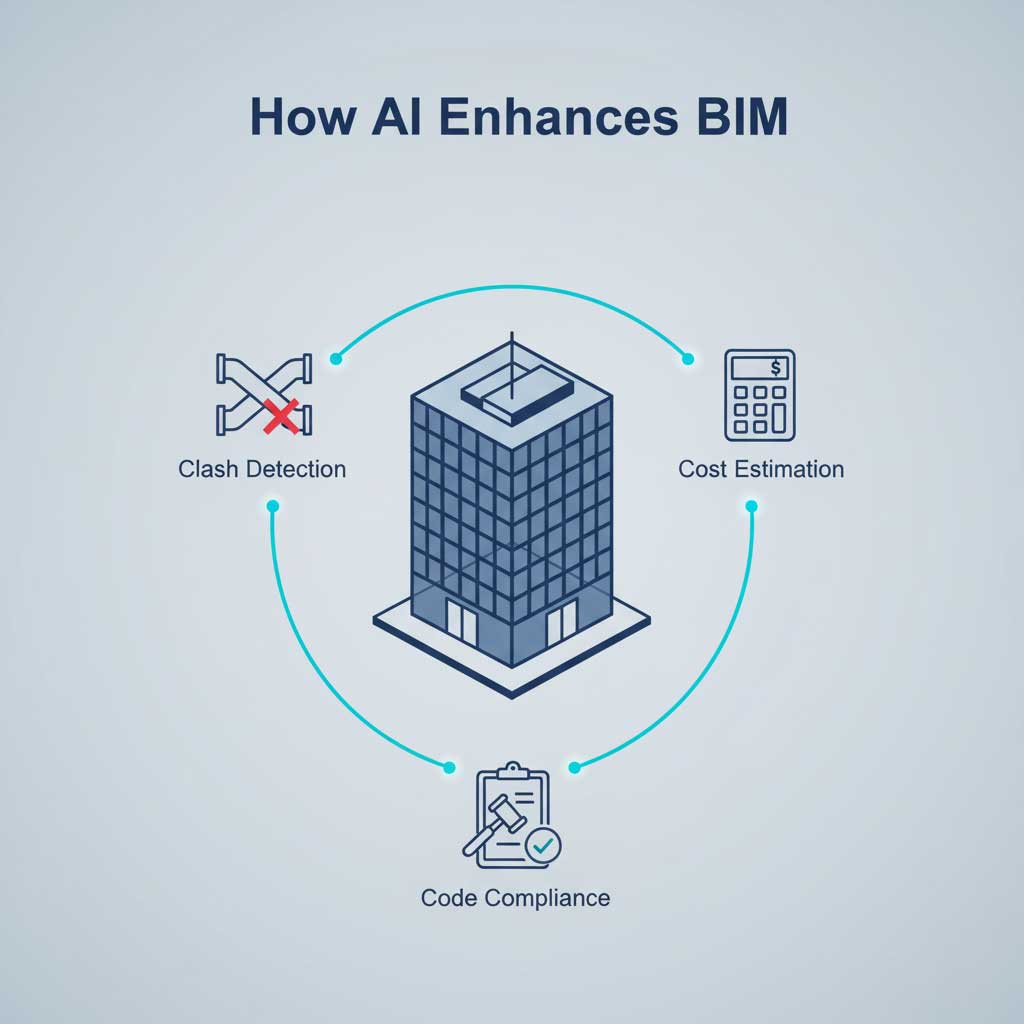
How It Works
AI algorithms analyze BIM models to perform tasks that once required painstaking manual review. This includes automated clash detection, where the AI finds every instance of a pipe running through a beam, or automated building code compliance checks, flagging violations in real-time.
Benefits of AI in BIM
- Drastic Error Reduction: It prevents costly rework on site by catching conflicts during the design phase.
- Enhanced Cost Estimation: AI can analyze model components to provide more accurate and dynamic cost estimates.
- Improved Project Scheduling: By analyzing dependencies, AI can help optimize construction timelines.
Case Study: AECOM’s Global Infrastructure Projects
Global engineering and architecture giant AECOM leverages AI and BIM to manage the complexity of its large-scale infrastructure projects. By integrating AI-powered analytics into their BIM workflows, they can automate clash detection, optimize resource allocation, and ensure project data is consistent across global teams. This is a key part of modern AI construction management.
3. Sustainable Architecture AI: Designing for a Greener Planet
Achieving true sustainability requires complex analysis of countless environmental factors. Sustainable architecture AI provides the computational power to analyze these variables and deliver optimized, high-performance building designs.
How It Works
AI tools can process vast datasets on local climate, solar paths, wind patterns, and material lifecycle costs. They run thousands of simulations to determine the optimal building orientation, window placement, facade design, and material selection to minimize energy consumption and environmental impact.
Benefits of Sustainable Architecture AI
- Maximized Energy Efficiency: AI finds the perfect balance of design elements to reduce heating, cooling, and lighting loads.
- Informed Material Selection: It can analyze the embodied carbon and lifecycle cost of materials to recommend the most sustainable options.
- Climate-Responsive Design: Ensures buildings are designed to perform optimally in their specific environmental context.
Case Study: Skidmore, Owings & Merrill (SOM)
The renowned firm SOM uses advanced simulation and AI tools as a core part of its design process. For their high-performance skyscrapers, they use AI to analyze and optimize facade designs, balancing aesthetic goals with the need for energy efficiency AI in buildings. This data-driven approach allows them to create structures that are both iconic and environmentally responsible.
4. AI Architectural Visualization: Photorealism in Minutes
Architectural visualization has always been a time-consuming but essential part of the design process. AI architectural visualization is radically accelerating this workflow, allowing architects to generate stunning, photorealistic images from simple models in a fraction of the time.
How It Works
AI renderers and text-to-image generators use machine learning models trained on millions of images. Architects can apply styles, materials, and lighting conditions using simple text prompts or by uploading reference images. The AI then interprets these inputs to produce a high-quality rendering almost instantly.
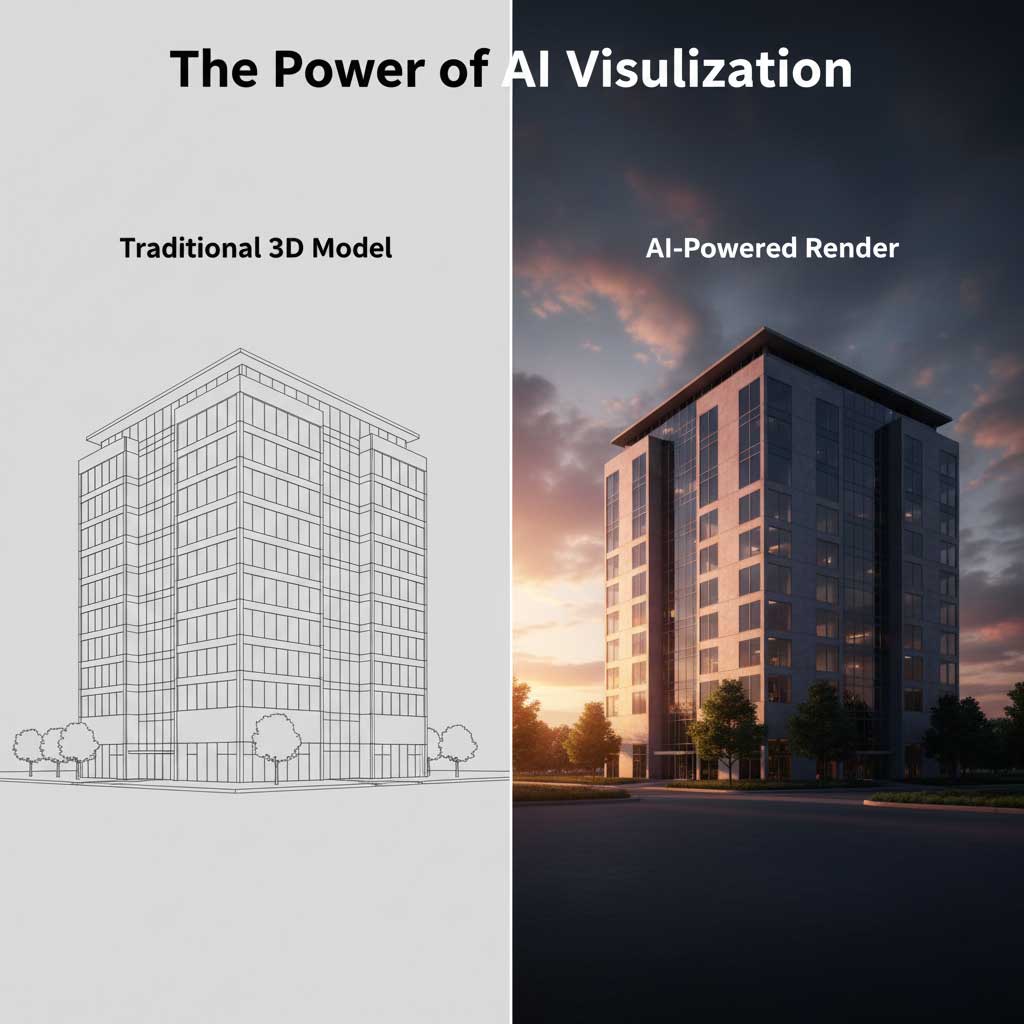
Benefits of AI Visualization
- Unprecedented Speed: Renders that once took hours or days can now be generated in minutes.
- Enhanced Creativity: Allows for rapid experimentation with different moods, materials, and design aesthetics.
- Improved Client Communication: Helps clients visualize the final product earlier and more clearly in the design process.
Case Study: Veras by EvolveLAB
Veras is a popular AI tool that works as a plugin for software like Revit and SketchUp. It allows an architect to take a basic 3D model and use AI to explore countless rendering options. A designer can prompt it to show the building “at sunset, in a brutalist style, with lush vegetation,” and receive a high-quality image in seconds. This rapid iteration is a game-changer for conceptual design and client presentations.
5. AI in Urban Planning: Shaping the Smart Cities of Tomorrow
The power of AI in architecture extends beyond individual buildings to entire urban landscapes. AI for urban planning helps designers, developers, and policymakers analyze complex city-scale systems to create more livable, sustainable, and equitable communities.
How It Works
AI platforms can process massive datasets including geographic information, traffic patterns, demographic data, and environmental factors. They use this information to model different development scenarios, optimizing for things like walkability, public transit access, green space distribution, and infrastructure efficiency.
Benefits of AI in Urban Planning
- Data-Informed Decision Making: Replaces guesswork with models based on real-world data.
- Holistic System Analysis: Understands how a change in one area (e.g., a new transit line) will affect others.
- Sustainable Community Design: Helps plan cities that are more resilient, efficient, and pleasant to live in.
Case Study: Sidewalk Labs’ Delve Platform
Sidewalk Labs (an Alphabet company) developed a platform called Delve that used generative design and AI to help urban planners and real estate developers design better neighborhoods. Users could input design priorities—such as maximizing green space or minimizing infrastructure costs—and the platform would generate and evaluate thousands of possible designs, revealing the optimal solutions.
Comparison of the Best AI Software for Architects 2025
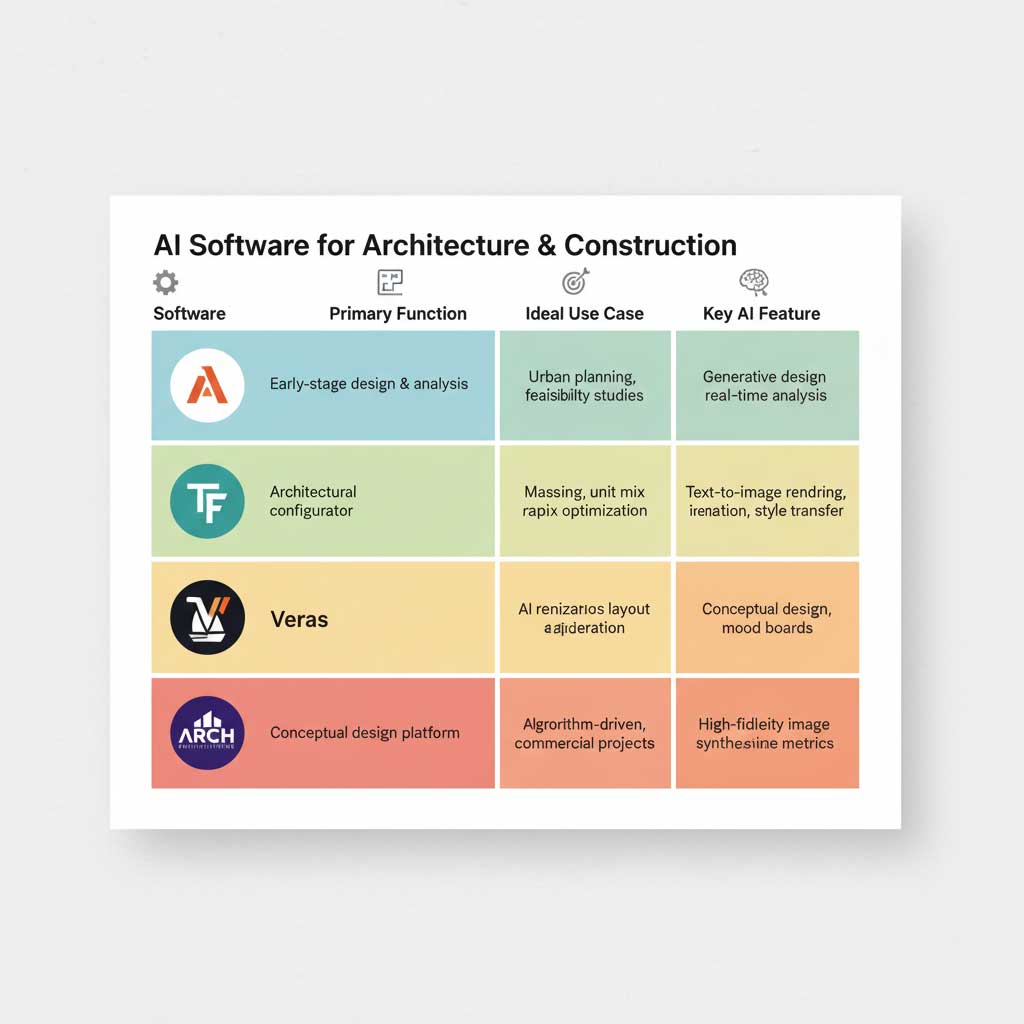
Choosing the right tool is critical for successfully implementing AI for architects. The software landscape is evolving rapidly, but a few key players have emerged as leaders in different categories. This table compares some of the best AI software for architects available today.
| Tool | Primary Function | Ideal Use Case | Key AI Feature | Integrates With |
| Autodesk Forma | Sustainable Urban Planning | Early-stage site analysis and massing studies | AI-powered environmental analysis (sun, wind, noise) | Revit, Other Autodesk Suite |
| TestFit | Generative Design | Real estate feasibility and multi-family housing design | Instantly generates thousands of code-compliant building layouts | Revit, Rhino, SketchUp |
| Veras | AI Visualization | Creating photorealistic renders from 3D models | AI-powered rendering engine with style prompts | Revit, SketchUp, Rhino, Forma |
| Midjourney | Conceptualization | Generating inspirational images and mood boards | Advanced text-to-image generation | Discord (Standalone) |
| ARCHITEChTURES | Generative Design | Residential building design optimization | Real-time parametric design and performance analysis | Revit, IFC format |
Practical Strategies: Adopting AI in Your Architectural Practice
Integrating AI in architecture can seem daunting, but it can be approached methodically. The goal is to enhance, not replace, existing workflows with powerful new capabilities.
A Step-by-Step Guide to Integrating AI into Your Workflow
- Identify Bottlenecks: Analyze your current design process. Where do you spend the most time on repetitive or low-creativity tasks? This could be early-stage feasibility studies, creating renders, or checking for model clashes.
- Start Small with One Tool: Don’t try to overhaul your entire process at once. Begin with a single, high-impact tool. For many firms, an AI architectural visualization tool like Veras is a great entry point due to its immediate and tangible benefits.
- Invest in Team Training: Technology is only as good as the people who use it. Dedicate time for training and allow for an experimentation phase where the team can learn how to best leverage the new software.
- Measure the Return on Investment (ROI): Track key metrics before and after implementation. This could include time saved on conceptual design, reduction in construction errors, or faster client approvals. This data will justify further investment in AI-powered architecture.
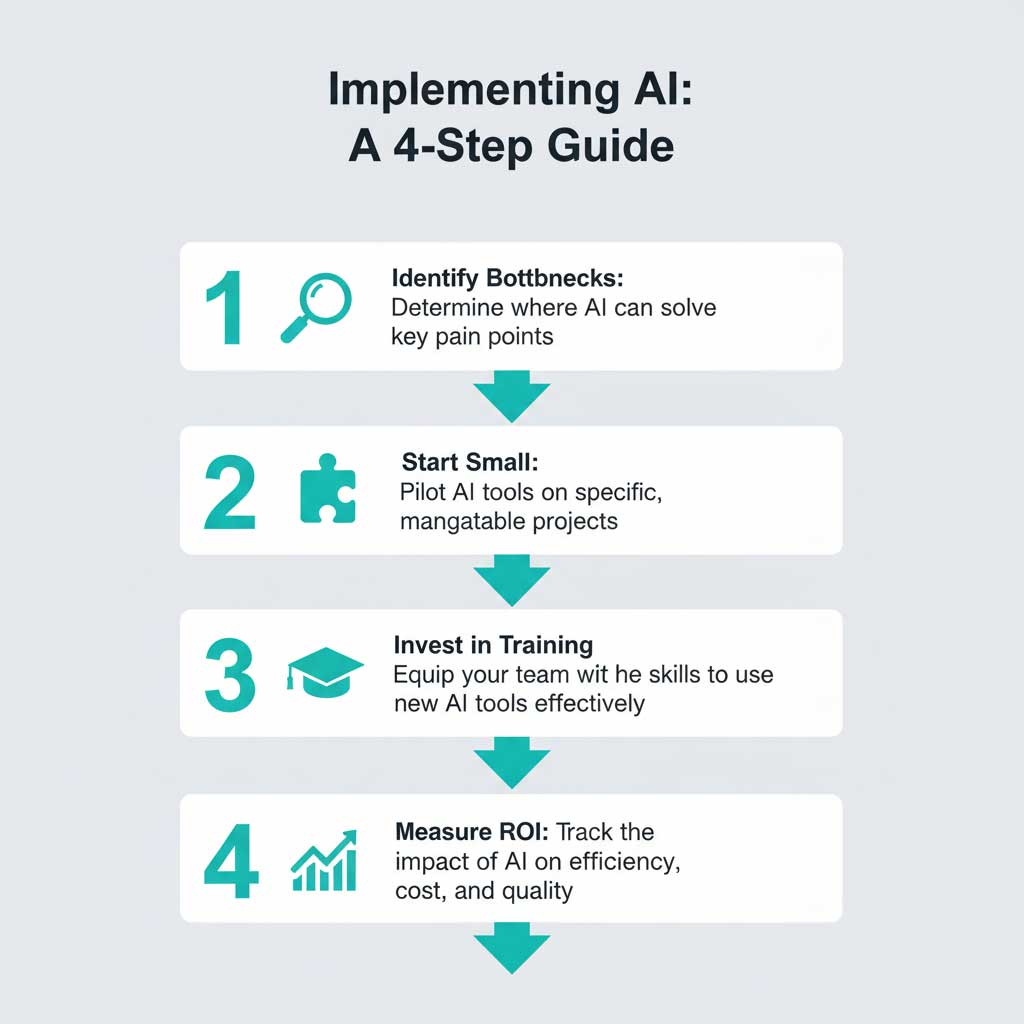
Do AI Architects Need Coding Skills? The Rise of No-Code Platforms
A common misconception is that using AI requires programming knowledge. While coding skills are certainly an advantage for developing custom solutions, the vast majority of modern AI-driven design tools are built with architects, not programmers, in mind.
Platforms like TestFit, Forma, and Veras feature intuitive, visual interfaces that allow designers to leverage powerful AI without writing a single line of code. The rise of these no-code platforms is democratizing access to AI for architects, making it a viable tool for firms of all sizes.
The Future of Architecture AI: Trends and Ethical Questions
The integration of AI in architecture is still in its early stages. The coming years will see even more profound changes as the technology matures and becomes more deeply embedded in the design process.
On the Horizon: Digital Twins and Predictive Maintenance
One of the most exciting future trends is the concept of the “digital twin.” This is a live, data-rich virtual model of a physical building that is continuously updated with real-world sensor data. AI will use these digital twins to run simulations, predict maintenance needs before equipment fails, and optimize building operations in real-time.
The Big Question: Will AI Replace Architects?
This is perhaps the most frequently asked question, and the answer is a resounding no. AI is a tool, not a replacement. It excels at computation, data analysis, and optimization—tasks that are often tedious and time-consuming for humans. This automation will free architects from repetitive work.
This allows them to focus on the things that AI cannot do: creative problem-solving, strategic thinking, client empathy, ethical judgment, and cultural understanding. The future of the profession lies in a collaborative model where the architect acts as the creative and strategic leader, guiding powerful AI tools to achieve their vision.
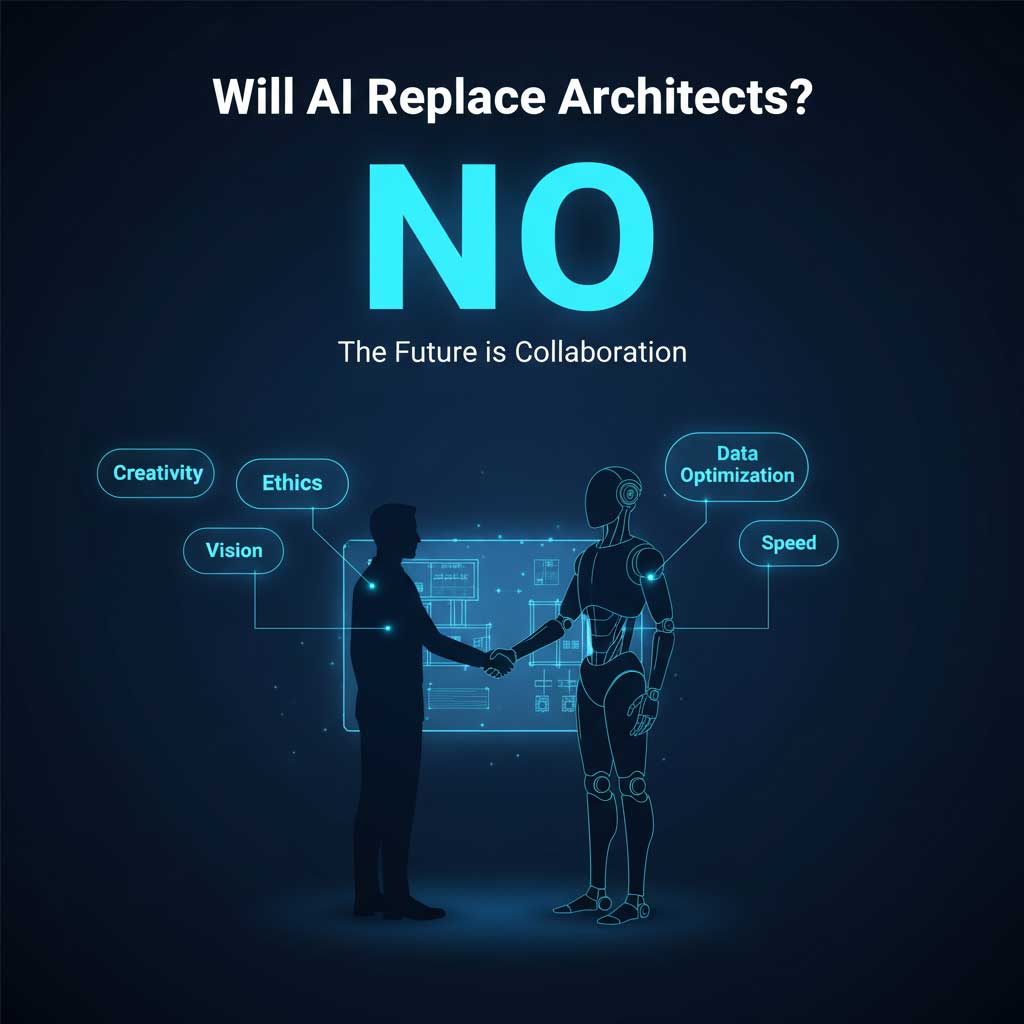
Challenges and Ethical Considerations
Adopting any powerful new technology comes with challenges. With AI in architecture, these include:
- Stylistic Homogenization: An overreliance on AI could lead to designs that are optimized but lack soul or local character.
- Data Bias: AI models are trained on existing data. If that data contains historical biases (e.g., designs that ignore accessibility), the AI may perpetuate them.
- Cost and Accessibility: The most powerful tools can be expensive, potentially creating a divide between large and small firms.
- Human Oversight: It is crucial that architects remain in control, using their professional judgment to validate and refine the outputs generated by AI.
Summary & Key Takeaways
The integration of AI in architecture marks a pivotal moment for the industry. From concept to construction, artificial intelligence is providing tools that enhance creativity, improve efficiency, and enable the design of more sustainable and intelligent buildings.
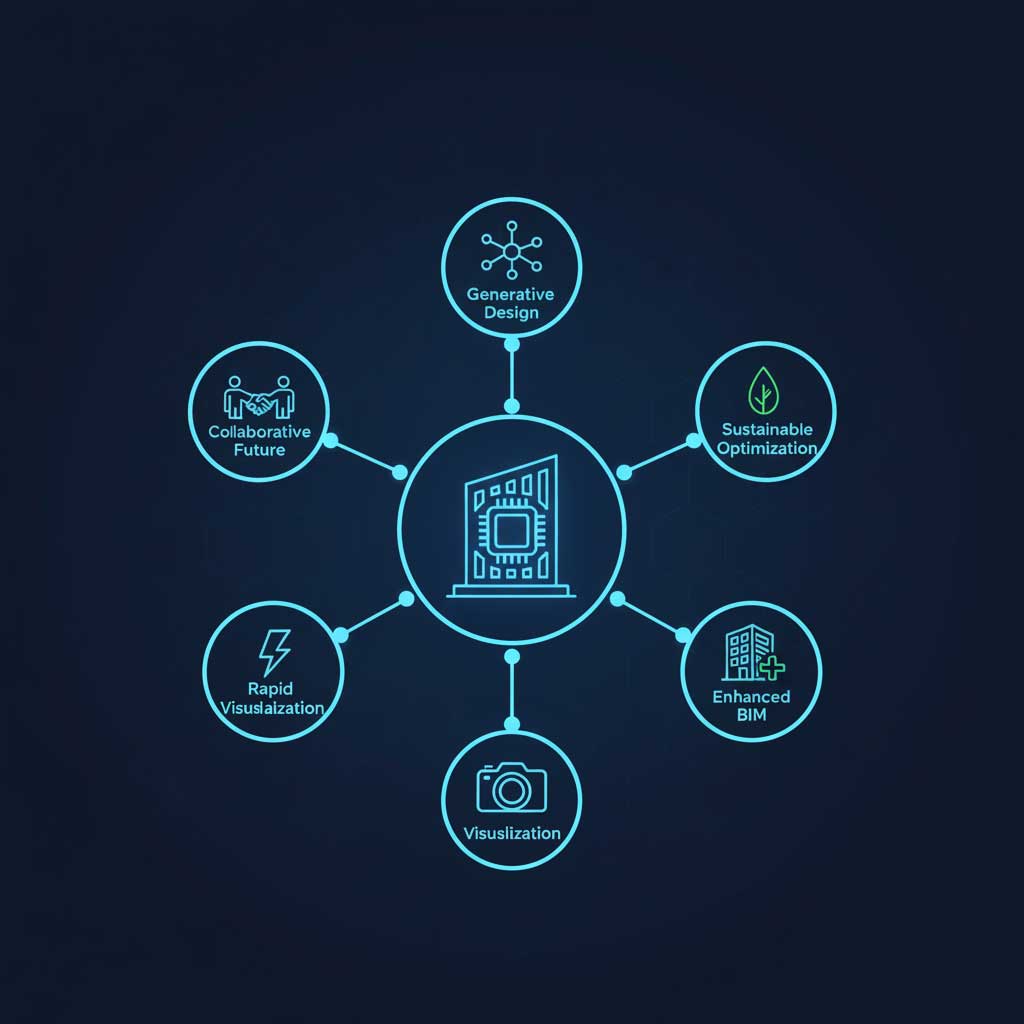
We’ve seen how generative design architecture can explore thousands of options in an instant, how AI and BIM are creating smarter and more accurate construction models, and how sustainable architecture AI is helping us tackle the climate crisis. The real-world examples of AI in architectural projects from firms like SOM and Autodesk prove this is no longer science fiction.
Ultimately, the future of architecture with AI is a collaborative one. By embracing AI-powered architecture, designers can offload complex computation and focus on what truly matters: creating thoughtful, beautiful, and human-centric spaces.
Frequently Asked Questions (FAQs)
What is a real-world example of AI architecture?
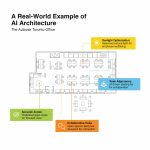
The Autodesk office in Toronto is a prime example. Its entire floor plan was optimized using generative design to meet complex goals for employee collaboration, work styles, and access to natural light, resulting in a data-driven, human-centric workspace.
What AI tools do architects use most?
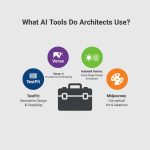
Architects are increasingly using a suite of AI tools. For generative design, TestFit and Autodesk Forma are leaders. For rapid visualization, Veras and Midjourney are popular. And for smarter project management, AI features within BIM platforms are essential.
Can AI create a full architectural design?
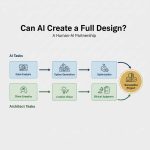
AI can generate highly detailed design options and floor plans based on a set of rules and goals. However, it cannot yet manage the entire architectural process, which requires human creativity, client communication, and critical judgment.
Is there a ChatGPT for architecture?
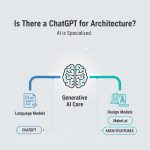
While there isn’t a single “ChatGPT for architecture,” specialized generative tools like Maket.ai and ARCHITEChTURES use similar AI principles to generate and optimize residential building designs based on user inputs.
How does AI contribute to sustainable architecture?

AI analyzes vast environmental datasets to optimize a building’s orientation, material choices, and energy systems. This data-driven approach allows architects to significantly reduce a building’s carbon footprint and long-term operational costs.
What are the negatives of AI in architecture?
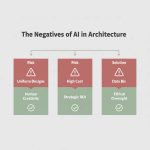
The primary concerns include the potential for uniform, uninspired designs if AI is used as a crutch, the high cost of sophisticated software, and ethical questions around data bias and the future of entry-level architectural roles.
What is the difference between generative design and parametric design?

In parametric design, the architect defines rules and then manually adjusts parameters to explore variations. In generative design, the architect sets high-level goals and constraints, and the AI autonomously explores thousands of solutions to find the best ones.
Will architects need to learn to code?

For the most part, no. The vast majority of AI tools for architects are designed with user-friendly, visual interfaces that do not require any coding knowledge, making the technology accessible to all designers.
How is AI used in construction management?
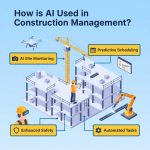
In construction, AI is used to monitor job sites via drones and cameras, predict project delays by analyzing progress data, automate scheduling, and enhance worker safety by identifying potential hazards in real-time.
What is the future of AI in architecture?
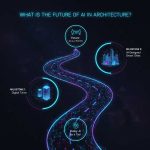
The future points toward a deeper, more seamless integration. AI will act as a real-time collaborator during the design process, manage complex “digital twins” of buildings for operational efficiency, and play a crucial role in designing entire sustainable cities.









